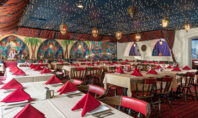Egypt
In the early 18th century, settlers left Berks County and western Lehigh County and headed east in search of better soil to grow crops and livestock.
They came to what is now the northwestern corner of Whitehall Township because of its rich soil and named the place Egypta, later Egypt, because it reminded them of the fertile Nile delta, “the granary of the world.”
At first, the name Egypt was loosely applied to land lying on both sides of the Lehigh River from Allentown up to the Blue Mountain; later, it was confined to Whitehall Township.
40°40′48″N 75°31′48″W
COUNTY: LEHIGH
ZIP CODE: 18052
POPULATION: 2,391
Word of the idyllic location soon reached family and friends back in the Rhineland-Palatinate state of what is now southwest Germany.
“Once someone settled there, their neighbors from the Old Country seemed to follow and settle in the same place,” says Karen Gensey, Whitehall Township historian and author of “Whitehall, Pennsylvania: the Golden Strip of the Lehigh Valley.”
“Jacob Kohler, a farmer, was the first to stake a claim here, and later Peter Steckel.”
A church and school were soon built, attracting more people to the area, but growth really took off about 150 years later with the rise of the cement industry. Hotels, the Ironton Railroad (now a rail trail), blacksmiths, a post office, and 175 inhabitants were the direct result of the establishment in 1884 of the American Cement Works, which was purchased in 1913 by Giant Portland Cement.
Limestone, a raw material for cement, was quarried in nearby Ormrod, Coplay, Bath, and Nazareth. With the establishment of Whitehall as a first-class township in the early 20th century, Egypt had grown to include two churches, an eight-room schoolhouse, 14 stores and six small industries. More growth occurred in the 1970s as housing development expanded northward from the township, consuming farmland.
“I love the history and that it still has that hometown feel,” says Gensey, a descendant of Egypt’s founder, Jacob Kohler.
Despite the growth, Egypt’s past charms still echo down the old commercial corridors along Main and Church Streets.
EGYPT THROUGH THE YEARS
1728
Jacob Kohler, an immigrant from Switzerland, becomes the first settler along land in the bend of Coplay Creek.
1734
Kohler is joined by Peter Troxell, Ulrich Burghalter, Michael Hoffman, Nicholas Kern, Ulrich Flickinger, and Nicholas Saeger.
1756
The Troxell-Steckel House, the oldest house in Egypt, is built. Listed on the National Register of Historic Places, the restored stone farmhouse is maintained by the Lehigh County Historical Society.
1809
John Kohler builds a third mill to replace the one built by his grandfather to provide more water power to the growing community. It was in use for about 100 years.
1850
A covered bridge is built across Coplay Creek on Bridge Street.
1884
Egypt Mills, the first cement company in Egypt, ships its first load of cement to market on the Ironton Railroad.
1900
The Egypt Bakery Co. is started; by 1914, it was producing 15,000 loaves a bread delivered by three horse and wagon teams.
1914
Eberhardt Motors, still in business today, is established at the corner of Main and Church Streets.
1921
Egypt Fire Co. No. 1 is established.
1929
Egypt’s own Curt Simmons, a left-handed Major League pitcher, is born on May 19.
1966
The Egypt Post Office closes when Egypt becomes part of Whitehall Township for mail delivery.
Some of the earliest businesses are still in town, including George A. Kohler & Brothers, a fuel oil business and a fixture on South Church Street for more than a century. Built by Jacob Steckel in 1790, the old Egypt Hotel, now Riley’s Restaurant & Pub, still stands at Main and South Church Streets. A store, hotel, tavern, post office, ice cream parlor, and dance hall, the landmark has long served as a hub of the community.
“I just enjoy life here,” says Gary Weaver, a sixth-generation Egyptian who still lives in the family’s 19th century clapboard home—the only home on Main Street with a barn in the backyard and remnants of the former Egypt Chicken Farm. “It’s nice to have the Coplay Creek behind the house, a pleasant place to take a quiet walk.”
His forbearers, many of whom worked in the cement industry, also left their mark on a business that’s still well-known throughout the Lehigh Valley.
“My great-great grandfather, Tilghman Weaver, started the Egypt Bakery in 1898 and delivered the baked goods by horse-drawn wagon and later by truck,” Weaver says. Egypt Bakery eventually merged with another Egypt bakery, Star Bakery, to form Egypt Star Bakery, now based in Allentown.
“Bakeries were popular—there used to be another one, Weiner’s, also at Main and Church Streets,” Weaver recalls.
The hospitality business also began to flourish, an outgrowth of the cement industry and increasing development on MacArthur Road, once known as the Road from Egypt to Allentown. Besides the iconic Egypt Hotel, there were the Ballas Hotel and the City View Hotel, which was operated by Weaver’s uncle.
A pastoral crossroad most of the time, Egypt did make its mark in local history when the country’s taps and distilleries went underground during Prohibition.
“The Lindaman and Keefer bottling company, which bottled whisky along with soft drinks, was the site of the first Prohibition raid in Lehigh County on December 9, 1920,” Gensey says. “We also had the Kleckner News Agency, which started in 1907 and evolved into Kleckner & Sons appliances.”
While Egypt’s days as a bustling center of commerce are part of local history, Weaver says activities at four local churches and the Egypt Memorial Park help maintain a strong local identity.
“You used to be able to go up and down Main Street and hear people speaking Pennsylvania Dutch. You can still hear a little bit now and then,” Weaver says. “But we still have so much to be thankful for with the history that’s been preserved.
Curt Simmons, Hometown Hero
One of Egypt’s most famous sons, Curt Simmons, launched his baseball career at Whitehall High School, striking out 102 hitters in 48 innings and giving up only 12 hits during his senior year and leading his team to three straight Lehigh Valley championships.
Just about every major-league club was interested in the left-handed schoolboy phenomena, and the Phillies even came to watch him play in an exhibition game it arranged at Egypt Memorial Park in June 1947.
The same year, Simmons signed with the Philadelphia Phillies shortly after his 18th birthday, putting on a promising performance in the minors by winning 13 and losing five in 18 starts, striking out 197 batters in only 147 innings.
The Phillies brought him up to make his major league debut in 1947 against the New York Giants; Simmons won 3-1, striking out nine.
Simmons’ talent at the mound helped the Phillies win a national championship in 1950. His career, 1947 to 1950 and 1952 to 1967, earned him a place in the Baseball Hall of Fame. Fellow Hall of Famer Hank Aaron has always listed Simmons first as the toughest pitcher he ever faced.
Every year, Egypt pays tribute to his legacy by holding Curt Simmons Day at Egypt Memorial Park, a communitywide celebration. This year’s event is June 1.
Troxell-Steckel Farm Museum
In 1737, Johann Troxell, with his wife and teenaged children, stepped ashore at the port of Philadelphia. Born in Switzerland, he had spent most of his life in what today is southwestern Germany. Now his family joined the many Germans moving to Pennsylvania in hopes of a better life.
The Troxells bought 400 acres in the district called Egypt, in what today is Whitehall Township. For generations to come, life in Egypt and similar communities would see German traditions mingling with those of other local ethnic groups to form a distinctive Pennsylvania German culture.
In 1756, Johann’s son Johann Peter built one of the finest stone homes in the township on the family farm. In the Germanic tradition, the house features a blessing stone and arched windows. The house also has a central hallway, typical of the architecture popular in England at that time.
In 1768, Johann Peter Troxell and his family left the Lehigh Valley after selling their farm to Peter Steckel, who lived there with his family until his death in 1866.
Families were patriarchal and closely knit, with clearly defined roles. Women, girls, and boys cared for the house, garden, chickens, and cows. Older boys and men cared for the animals and worked the fields growing grain. The first floor of the mid-1800s bank barn housed animals including chickens, pigs, horses, and cows. The hill or “bank” leading to the barn’s second floor let wagons full of crops pull into that level for crop storage.
While farmers grew or made most of what they needed, they still relied heavily on others. Farm families engaged actively in a trading network that linked them with the region, nation, and world. In 1840, Egypt had a mill for grinding grain, a tannery, and a store, as well as a school, a church, and a tavern.
After Peter Steckel’s death in 1866, the farm was eventually sold out of the family. In the 1940s, A.P. Steckel bought the house and gave it to the Lehigh County Historical Society. Today it has been restored and stands as a place where visitors can catch a glimpse of life in the heyday of Pennsylvania German rural culture.
The 1756 Troxell-Steckel Farm Museum, listed on the National Register of Historic Places, is open for annual events or by appointment for groups. Call the Lehigh County Historical Society, 610-435-1074, to make arrangements.


















